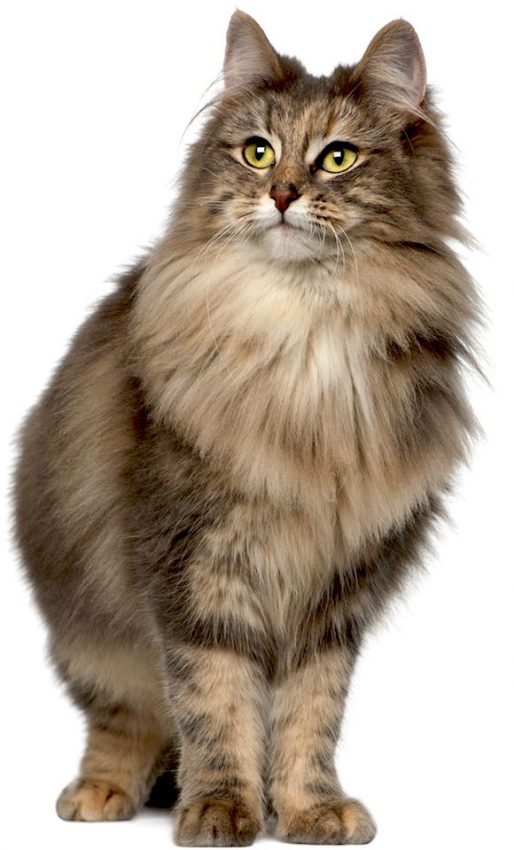
1. Key Characteristics of Norwegian Forest Cats
- Weight: 12–16 pounds for males; 9–12 pounds for females
- Life Expectancy: Around 15 years
Norwegian Forest Cats (a.k.a. Wegies) have a large, powerful and muscular body and a triangular head.
Their eyes are also large and almond-shaped, and their big ears arch forward. The tail is long and bushy, with heavier hair during the winter.
The water-resistant double coat protects Norwegian Forest Cats from the harsh winters and features semi-long hair. The undercoat is dense and thickens during the cold months. It’s thinner and shorter during warmer months.
Coat colors and patterns can be any variety except colorpoint.
2. Where Norwegian Forest Cats Came From
The Norwegian Forest Cats is an old cat breed from Norway. They are called “skogkatt” in their home country, which translates to “forest cat.”
The cats are believed to have accompanied Vikings on their ships to eradicate rodents, the same job they performed in the Norwegian countryside.
The cats began breeding with shorthaired strays and were in danger of being bred out. So cat fanciers in Norway started a breeding program, but their efforts were halted because of World War II. Thankfully, they restarted after the war and succeeded in breeding.
Designated as the official cat of Norway by King Olaf, Norwegian Forest Cats began appearing in cat shows, and the breed was exported to the United States in 1979.
The Cat Fanciers’ Association (CFA) recognized the breed in 1987 and assigned it championship status in 1993, while the International Cat Association assigned championship status to the breed in 1984.

3. How Friendly Are Norwegian Forest Cats?
Maturity takes a long time for this breed — around 5 years, in fact.
Norwegian Forest Cats are intelligent, natural hunters who adapt easily to new situations and environments. They enjoy being around pets, people and toys.
However, their affection levels can vary — they can appear aloof at times.
4. Is This the Right Cat for You?
Exercise Needs
MEDIUM: Norwegian Forest Cats are moderately active and interactive.
They love to play and enjoy being on high surfaces, so cat towers or trees are a must for this breed.
These cats can also climb virtually any surface and are quite resourceful. After all that play, they love a long nap.
Keep your Norwegian Forest Cat indoors or in an enclosed outdoor play area. These cats are not only susceptible to theft, but the breed’s playful temperament means these cats also may not recognize outdoor dangers.
Was YOUR Pet Food Recalled?
Check Now: Blue Buffalo • Science Diet • Purina • Wellness • 4health • Canine Carry Outs • Friskies • Taste of the Wild • See 200+ more brands…

Grooming Needs
MEDIUM: Brush your Norwegian Forest Cat just once a week. Wegies are considered low-maintenance cats for most of the year, but they need a little extra care after winter.
During the winter, the double coat is really thick, but it will thin out as spring approaches, so you’ll need to brush a lot more at this time (perhaps 3 times a week).
Health Problems
LOW: Norwegian Forest Cats are a healthy breed, but some conditions are more common, including:
- Glycogenosis (a rare inherited glucose abnormality)
- Hypertrophic cardiomyopathy (heart problem)
Learn more about Norwegian Forest Cats in this video:

5. Where to Adopt a Norwegian Forest Cat
Check adoption resources first. Use our adoption search feature to get started, or search for local rescues.
If you go through a breeder to buy a Norwegian Forest Cat, please be aware that kitten mills do, in fact, exist. Check for a clean environment and request health checks to ensure the cats are being raised with the utmost care provided for their good health.




